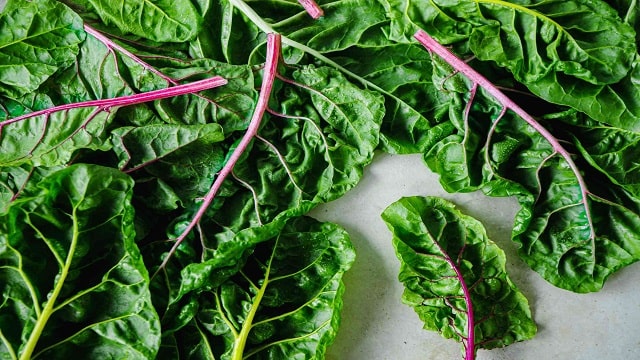Chard Meaning
Chard is a plant characterized by its intense green color, its large edible leaves, and its highly developed central nerve. It is mostly grown for use as food in meals, although it is also recognized for its health benefits.
The parts of the leaf that we eat are the petiole and the central veins of the leaf, which are quite fleshy. If it has not stopped growing, it can be eaten whole. However, if it is consumed after the growth period, the stems tend to have a very bitter and unpleasant taste.
It belongs to the family known as Chenopodiaceae, to the Cicla variety, and is native to North Africa and the countries located on the coast of the Mediterranean Sea. There are two varieties, the white and the green, and both have the same properties.
The use of chard actually goes back in time, Roman, Greek, and Arab civilizations used it, while the Arabs were the first to impose its cultivation and discover its healing benefits.
It is worth noting that for its satisfactory growth and development, chard needs temperate climatic conditions, typical of coastal areas or saline soils. Although it is a biennial crop, it is normally grown annually.
Today , the United States is one of the main producers of this herb, although it should be noted that it was only discovered in the early 19th century. Other countries that also stand out in its production include Spain, Italy, France, Holland, England, and Belgium.
As with all green vegetables, chard is rich in vitamins A, C, B2, and minerals such as iron, potassium, sodium, phosphorus, and calcium. It is also notable for its easy and quick digestion.
Now, if you are wondering what condition or disease chard is good for, we can tell you that it is very good when it comes to treating inflammation in the bladder, duodenum, hemorrhoids, sores, to combat constipation and as a diuretic. Also, its regular consumption is very good for developing and keeping the memory active.
Chard Meaning in Hindi
चार्ड एक ऐसा पौधा है जिसकी विशेषता इसका गहरा हरा रंग, इसकी बड़ी खाद्य पत्तियाँ और इसकी अत्यधिक विकसित केंद्रीय तंत्रिका है। इसे ज़्यादातर भोजन में इस्तेमाल के लिए उगाया जाता है, हालाँकि इसे इसके स्वास्थ्य लाभों के लिए भी जाना जाता है।
पत्ती के वे हिस्से जिन्हें हम खाते हैं, वे पत्ती की डंठल और केंद्रीय शिराएँ हैं, जो काफी मांसल होती हैं। अगर यह बढ़ना बंद नहीं हुआ है, तो इसे पूरा खाया जा सकता है। हालाँकि, अगर इसे विकास अवधि के बाद खाया जाता है, तो तने में बहुत कड़वा और अप्रिय स्वाद होता है।
यह चेनोपोडियासी नामक परिवार से संबंधित है, जो सिक्ला किस्म का है, और उत्तरी अफ्रीका और भूमध्य सागर के तट पर स्थित देशों का मूल निवासी है। इसकी दो किस्में हैं, सफ़ेद और हरा, और दोनों में एक जैसे गुण हैं।
चार्ड का उपयोग वास्तव में समय से पहले का है, रोमन, ग्रीक और अरब सभ्यताओं ने इसका इस्तेमाल किया, जबकि अरबों ने सबसे पहले इसकी खेती शुरू की और इसके उपचार लाभों की खोज की।
यह ध्यान देने योग्य है कि इसके संतोषजनक विकास और वृद्धि के लिए, चार्ड को समशीतोष्ण जलवायु परिस्थितियों की आवश्यकता होती है, जो तटीय क्षेत्रों या खारी मिट्टी के लिए विशिष्ट है। हालाँकि यह एक द्विवार्षिक फसल है, लेकिन इसे आम तौर पर सालाना उगाया जाता है।
आज, संयुक्त राज्य अमेरिका इस जड़ी बूटी के मुख्य उत्पादकों में से एक है, हालाँकि यह ध्यान दिया जाना चाहिए कि इसे केवल 19वीं शताब्दी की शुरुआत में खोजा गया था। अन्य देश जो इसके उत्पादन में भी आगे हैं, उनमें शामिल हैं: स्पेन, इटली, फ्रांस, हॉलैंड, इंग्लैंड और बेल्जियम।
सभी हरी सब्जियों की तरह, चार्ड विटामिन ए, सी, बी2 और आयरन, पोटेशियम, सोडियम, फॉस्फोरस और कैल्शियम जैसे खनिजों से भरपूर होता है। यह अपने आसान और त्वरित पाचन के लिए भी उल्लेखनीय है।
अब, यदि आप सोच रहे हैं कि चार्ड किस स्थिति या बीमारी के लिए अच्छा है, तो हम आपको बता सकते हैं कि मूत्राशय, ग्रहणी, बवासीर, घावों में सूजन के इलाज, कब्ज से निपटने और मूत्रवर्धक के रूप में यह बहुत अच्छा है। साथ ही, इसका नियमित सेवन याददाश्त को विकसित करने और सक्रिय रखने के लिए बहुत अच्छा है।
